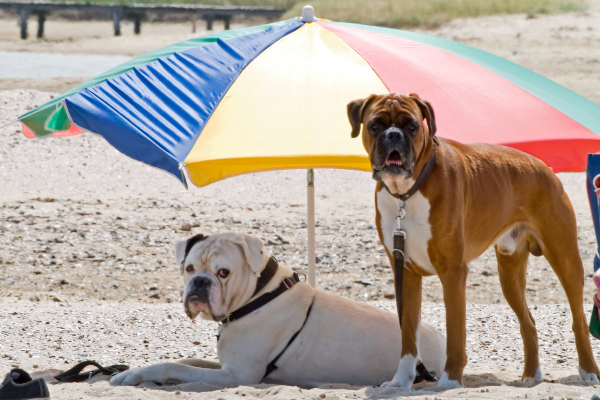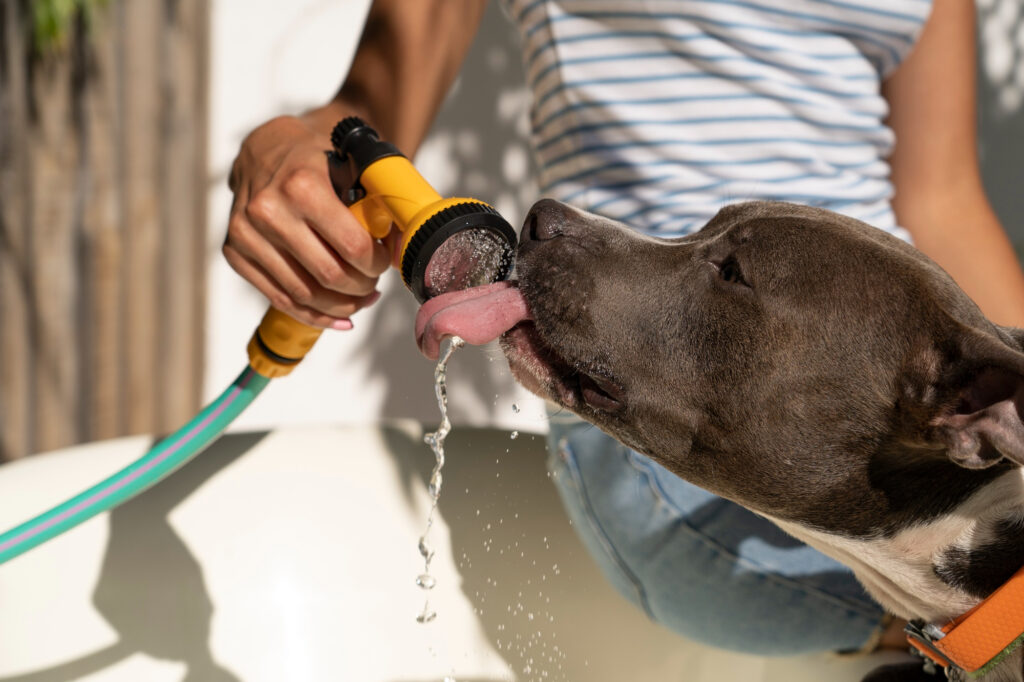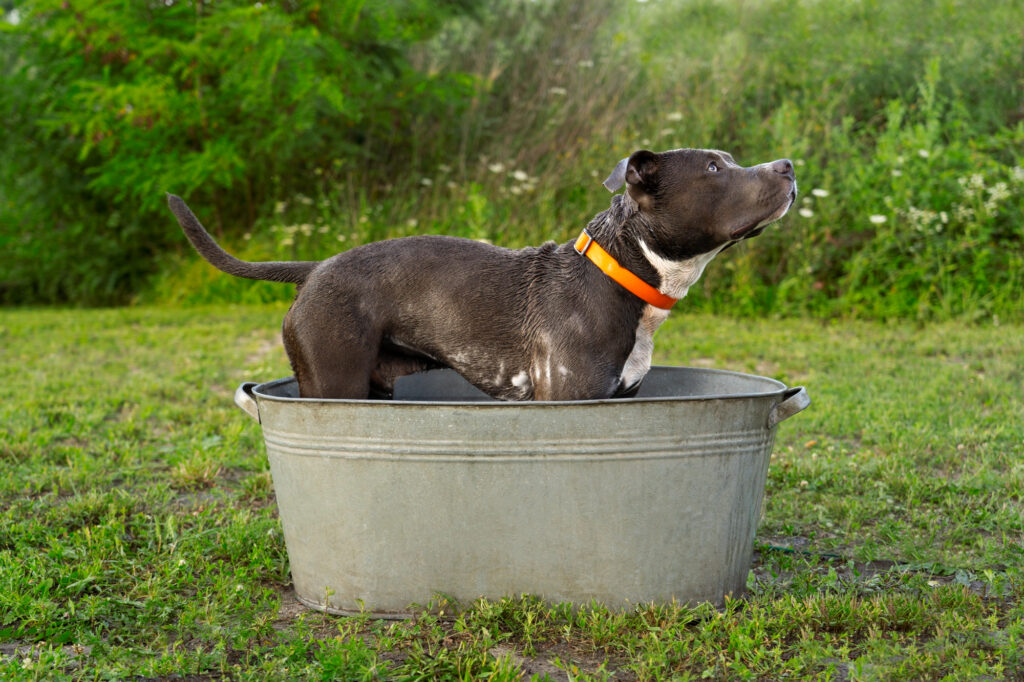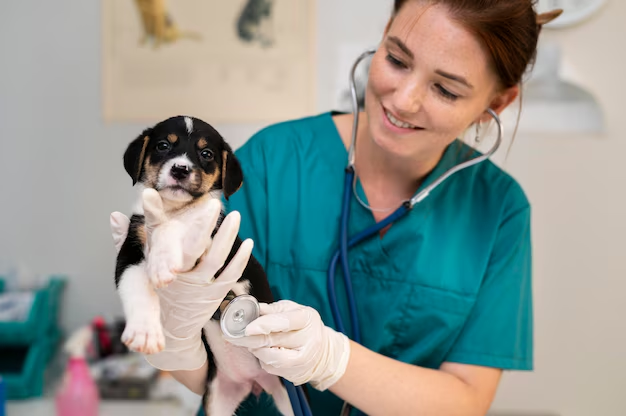Summer’s here, and the sunshine is glorious! But for our furry friends, the hot weather can be a real danger zone. While we might enjoy a bit of sunbathing, dogs can quickly overheat, leading to serious health problems.
The two main dangers from hot weather for dogs are heatstroke and heat exhaustion. They sound similar, but they’re quite different. Knowing the signs of each can help you keep your pooch safe and cool this summer.
In this guide, we’ll explore the key differences between heatstroke and heat exhaustion in dogs. We’ll also share some top tips on how to prevent your dog from overheating, and what to do if you suspect they’re suffering from heat-related illness.
Table of Contents
ToggleHeatstroke vs. Heat Exhaustion in Dogs: What’s the Difference?
Heat Exhaustion:
Think of heat exhaustion as your dog’s body overheating, but it hasn’t reached a critical point yet. It’s the body’s way of saying, “Woah there, things are getting a bit too toasty for me!” Thankfully, heat exhaustion is treatable, but it’s important to act quickly to prevent it from progressing to heatstroke.

Signs of Heat Exhaustion:
- Excessive panting and drooling
- Weakness or lethargy
- Stumbling or disorientation
- Excessive thirst
- Vomiting or diarrhoea
- Bright red gums or tongue
Heatstroke:
Heatstroke is a life-threatening condition. It occurs when a dog’s body can no longer regulate its temperature, and it keeps rising dangerously high. This can damage organs and even lead to death if not treated immediately.

Signs of Heatstroke:
- All the signs of heat exhaustion (listed above)
- Very high body temperature (over 104°F or 40°C)
- Glazed or bloodshot eyes
- Seizures or unconsciousness
- Difficulty breathing
- Thick, sticky drool
Keeping Your Cool Pup Cool: Top Tips to Prevent Heatstroke
The best way to deal with heatstroke and heat exhaustion is to prevent them in the first place. Here are some top tips to keep your furry friend cool and comfortable during the hot weather:
- Walkies in the Shade: Avoid walking your dog during the hottest parts of the day. Early mornings or evenings are much cooler and safer for exercise. If you must go out during the midday sun, stick to shaded areas like parks with plenty of trees.
- Hydration is Key: Make sure your dog has access to fresh, clean water all the time. Carry a portable water bowl with you on walks and outings, and encourage your dog to drink regularly.

- Cool Down Time: Plan plenty of rest breaks during walks, especially on hot days. Find shady spots for your dog to relax, or offer them a cooling pad to lie on.
- Leave the Fur On: It might seem counterintuitive, but shaving your dog’s fur completely can actually make them hotter! Their fur acts as insulation, protecting them from the sun’s rays. Regular brushing to remove dead fur is a better option for keeping them cool.
- Sun Protection for Light-Coloured Noses: Dogs with pink noses can be susceptible to sunburn. Apply a small amount of dog-safe sunscreen (SPF 15 or higher) to their nose before heading out.
- Never Leave Your Dog in a Hot Car: This one seems obvious, but it’s worth mentioning. Even with the windows cracked open, a parked car can heat up incredibly quickly, putting your dog at risk of heatstroke. On hot days, leave your furry friend at home in a cool, air-conditioned space if possible.
Quick Action Saves Lives: What to Do if Your Dog Shows Signs of Heatstroke
If you suspect your dog is suffering from heatstroke, it’s crucial to act quickly. Here’s what to do:
- Move Your Dog to a Cool Spot: Get your dog out of the heat and into a cool, shaded area as soon as possible.
- Cool Them Down Gradually: Don’t use ice baths or cold water, as this can cause shock. Instead, use a cool (not cold!) damp cloth or towel to wet their fur, focusing on areas like the belly, armpits, and groin. Let them drink small amounts of cool water if they’re conscious.
- Seek Veterinary Attention Immediately: Heatstroke is a serious medical emergency. Call your vet or the nearest emergency veterinary clinic right away. Don’t wait for your dog’s symptoms to improve before seeking help. Every minute counts when it comes to heatstroke treatment.

Here are some additional resources that you might find helpful:
- The Royal Society for the Prevention of Cruelty to Animals (RSPCA) has a great guide on keeping your dog cool in hot weather https://www.rspca.org.uk/adviceandwelfare/seasonal/summer.
- The PDSA (People’s Dispensary for Sick Animals) offers information on the signs and symptoms of heatstroke in dogs https://www.pdsa.org.uk/pet-help-and-advice/pet-health-hub/conditions/heatstroke-in-dogs.
Don’t Forget the Fun! Keeping Your Active Pup Happy During Hot Weather
Summer doesn’t have to be all about restrictions for your dog. There are plenty of fun ways to keep them cool and entertained during the hot weather:
- Cooling Games & Activities: Invest in some fun water toys for your dog to play with in the paddling pool or sprinkler. You can also try freezing some dog-safe treats in a Kong toy for them to lick and cool down with.
- Splash Time!: If your dog enjoys water, take them for a swim in a dog-friendly paddling pool or lake. Just remember to supervise them closely and never force them into the water if they’re scared.
- Sniffing Adventures: Early morning or evening walks can be a great way to keep your dog mentally stimulated without overexerting them in the heat. Let them explore new sniffy spots and enjoy the cooler temperatures.
- Indoor Fun: If it’s too hot to be outside, there are plenty of fun indoor games you can play with your dog. Hide and seek, puzzle toys, and short training sessions are all great ways to keep them mentally and physically stimulated in a cool environment.
By following these tips, you can help your dog stay cool, safe, and happy all summer long!
Remember, Your Dog Relies on You!
As dog owners, it’s our responsibility to keep our furry friends safe and healthy. By being aware of the dangers of hot weather and taking steps to prevent heatstroke and heat exhaustion, you can ensure your dog enjoys the summer months just as much as you do.
So, keep your pup cool, hydrated, and have a fantastic summer full of fun and adventures together!
Heatstroke vs Heat Exhaustion in Dogs: FAQs
Keeping your furry friend cool is crucial during hot weather. This FAQ section will help you understand the key differences between heatstroke and heat exhaustion in dogs, so you can take action and keep your pup safe.
1. What’s the difference between heatstroke and heat exhaustion in dogs?
Both heatstroke and heat exhaustion are serious conditions caused by overheating. However, they differ in severity:
- Heat exhaustion: This is the body’s early warning sign that it’s struggling to regulate temperature. It can progress to heatstroke if not addressed promptly.
- Heatstroke: This is a life-threatening condition where the body can no longer cool itself down. It requires immediate veterinary attention.
2. What are the symptoms of heat exhaustion in dogs?
Here are some signs your dog might be suffering from heat exhaustion:
- Excessive panting
- Excessive drooling
- Lethargy or weakness
- Wobbly walking or staggering
- Vomiting or diarrhea
- Bright red or pale gums
- Rapid breathing
3. What are the symptoms of heatstroke in dogs?
Heatstroke symptoms are more severe and require immediate action. Look out for:
- Very high body temperature (over 105°F)
- Disorientation or confusion
- Seizures or tremors
- Weakness or collapse
- Profuse drooling (may be thick and sticky)
- Bloody vomit or diarrhea
- Coma
4. What should I do if I think my dog has heat exhaustion?
If you suspect heat exhaustion, take immediate steps to cool your dog down:
- Move them to a shaded or air-conditioned area.
- Offer cool water to drink (avoid ice water).
- Wet their fur with cool (not cold) water or towels.
- Allow them to lick ice cubes (in moderation).
- Point a fan at them.
- Once they start cooling down, monitor their temperature and continue offering water.
- Contact your veterinarian for further guidance.
5. How can I prevent my dog from getting heatstroke?
Here are some crucial preventative measures to keep your dog cool:
- Limit walks and playtime during the hottest part of the day.
- Provide plenty of fresh, cool water and access to shade at all times.
- Never leave your dog unattended in a parked car, even with the windows cracked.
- Avoid strenuous exercise in hot weather.
- Consider cooling aids like cooling vests or mats.
- Plan activities like swimming or playtime for cooler times of the day.
- Be aware of breeds more susceptible to heatstroke, such as brachycephalic (short-nosed) dogs.
6. What if my dog refuses to drink water?
If your dog is reluctant to drink, you can try offering them flavored water made with a small amount of low-sodium chicken broth. You can also try wetting their mouth with cool water or placing ice cubes in their water bowl.
7. Should I take my dog’s temperature if I suspect heat exhaustion?
While not essential for initial action, taking your dog’s temperature rectally can help assess the severity. Use a digital thermometer with a lubricant and gently insert it about 1 inch into the rectum. A temperature above 103°F indicates potential heat exhaustion, and anything above 105°F requires immediate veterinary attention.
8. Can dogs recover from heatstroke?
With prompt veterinary treatment, dogs can recover from heatstroke. However, heatstroke can cause permanent organ damage if not addressed quickly. Early intervention is critical.
9. Are there any long-term effects of heatstroke in dogs?
Heatstroke can damage a dog’s organs, especially the brain, kidneys, and liver. Long-term effects can include seizures, personality changes, and organ failure.
10. What if I accidentally leave my dog in a hot car for a short time? Should I be worried?
Even a short period in a hot car can be dangerous for your dog. If you accidentally leave your dog in a hot car, check for signs of heat exhaustion or heatstroke. Take immediate action to cool them down and get them to veterinary care as soon as possible. Every minute counts.
